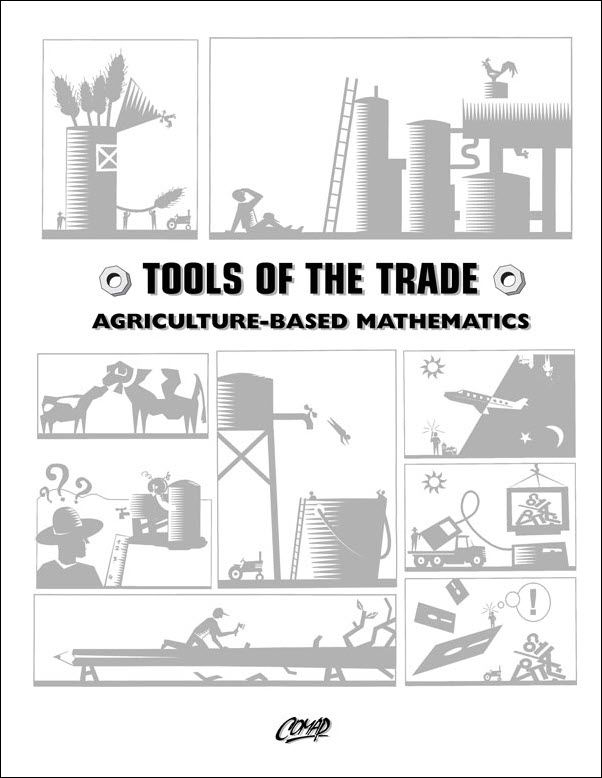Tools of the Trade: Unit 10: Growth of Wheat
Author: Project Co-Directors: Dave Engelhard, Michael Kallaher & Jack Robertson
Unit 10: Growth of Wheat: Purpose of Unit:
To provide exercises in ratio and proportion and percentages through interpretation of graphical information.
Note: The information below was created with the assistance of AI.
Level of Mathematics
Target Audience:
Best suited for middle school and early high school students (Grades 7–10).
Appropriate for general education students and those in agricultural science tracks.
Mathematics Involved:
Percentages: Interpreting relative quantities in plant growth stages.
Ratios and proportions: Comparing parts of the plant at different times.
Measurement and estimation: Using rulers to measure bar graph components.
Fractional reasoning: Determining proportions of total dry weight.
Basic arithmetic: Operations with decimals, fractions, and whole numbers.
Application Areas
Primary Context:
Agricultural science, specifically:
The developmental stages of wheat plants.
Tracking the dry matter contribution of different plant parts (leaves, stems, chaff, grain) through the plant’s lifecycle.
Real-World Applications:
Understanding crop yield composition.
Evaluating residue left in the field post-harvest, crucial for soil conservation and erosion management.
Decision-making around harvest timing and resource utilization.
Cross-disciplinary relevance:
Environmental science (erosion, residue management)
Plant biology (growth stages and structure)
Agricultural economics (yield calculation)
Prerequisites
Essential Skills:
Arithmetic proficiency: addition, subtraction, multiplication, division.
Comfort with percentages and ratios.
Ability to read and interpret bar graphs.
Use of rulers or measurement tools to extract quantitative data from graphs.
Supporting Concepts:
Understanding of plant parts and developmental stages.
Familiarity with basic units of weight (pounds, bushels) and volume.
Tools Used:
Ruler or other measuring device (as per instructions)
Calculator recommended for ease of computation
Subject Matter
Core Concepts Covered:
Graph Interpretation:
A bar graph illustrates the changing composition of the wheat plant (by dry weight) over eight key growth stages.
Students use measurements to estimate what fraction of the final dry weight each plant part comprises at each stage.
Conceptual Questions:
Which part dominates at each stage?
When do leaves become less than 50% of the plant?
What does the presence of chaff suggest about plant development?
Quantitative Computations:
Estimating percent composition of parts like stems, grain, and chaff at specific stages.
Translating those percentages into real-world quantities (e.g., pounds per bushel).
Real-world Yield Implications:
Calculating the non-harvested biomass (residue) based on grain weight.
Understanding its role in residue cover management (connected to Unit 20).
Assessment Tasks:
Comparing stages such as dough and ripe.
Estimating chaff mass based on given bushel weights.
Recognizing patterns and making agronomic inferences.
Correlation to Mathematics Standards
Common Core State Standards (CCSS) Alignment:
6.RP.A.3c: Solve percent problems using ratios.
6.EE.2c: Evaluate expressions in real-world problems.
6.SP.B.5: Summarize numerical data sets in context.
7.RP.A.2: Recognize and represent proportional relationships between quantities.
7.EE.3: Solve real-life problems using positive and negative rational numbers.
7.G.1: Solve scale drawing problems using measurement tools.
NCTM Process Standards:
Connections: Applies mathematics to agronomy and plant biology.
Representation: Uses graphs and tables to interpret change.
Problem Solving: Requires critical thinking and real-world modeling.
Mathematical Practices:
MP2: Reason abstractly and quantitatively.
MP4: Model with mathematics.
MP5: Use appropriate tools strategically.
MP6: Attend to precision.

Mathematics Topics:
Application Areas:
Prerequisites:
You must have a Full Membership to download this resource.
If you're already a member, login here.